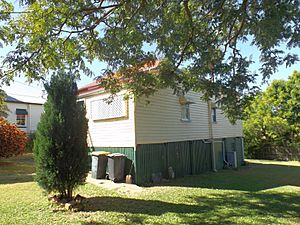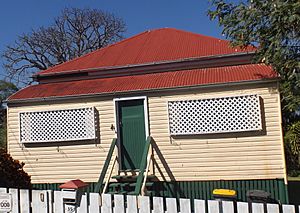Workers' Dwelling No.1 facts for kids
Quick facts for kids Workers' Dwelling No.1 |
|
|---|---|

Residence in 2015
|
|
| Location | 35 Surrey Street, Nundah, City of Brisbane, Queensland, Australia |
| Design period | 1900 - 1914 (early 20th century) |
| Built | 1910 |
| Official name: Workers' Dwelling No.1 | |
| Type | state heritage (built) |
| Designated | 21 October 1992 |
| Reference no. | 600273 |
| Significant period | 1910s (fabric, history) |
| Significant components | residential accommodation - main house, kitchen/kitchen house |
| Lua error in Module:Location_map at line 420: attempt to index field 'wikibase' (a nil value). | |
Workers' Dwelling No.1 is a special house in Nundah, Queensland, Australia. It was built in 1910. This house is important because it was the very first home built using a special government plan called the Queensland Worker's Dwelling Act of 1909. Today, it is listed on the Queensland Heritage Register, which means it's protected because of its historical importance.
Contents
A Home with History: The First Worker's Dwelling
This house was built in 1910 for a couple named Caroline and Otto Gustav Weissner. It was the very first home constructed under a new law called the Queensland Worker's Dwelling Act of 1909.
The Weissners bought the land in Nundah in June 1909. Then, on March 14, 1910, they applied for help to build their house. This new law helped them get a loan of £190 from the Worker's Dwelling Board. The total cost to build the house was £220. They finished paying off the loan in August 1925.
The house's design was simple and practical. It was a common style for working-class homes in Queensland at that time.
How the Worker's Dwelling Scheme Helped Families
The Worker's Dwelling Act was a government plan to help families buy their own homes. It was called the Worker's Dwelling Scheme.
- It helped people who earned less than £400 a year.
- They needed to own a suitable piece of land but not have a house yet.
- The government would lend them up to two-thirds of the total value of the land and the new house.
- The maximum loan amount was £300.
- People had 20 years to pay back the loan, with 5% interest.
This scheme was an early way the Queensland Government helped working families. It later led to the creation of the Queensland Housing Commission, which still helps people with housing today.
Over 30 years, the Worker's Dwelling Scheme helped build 23,515 houses across Queensland. It played a big part in how Brisbane's suburbs grew in the 1920s and 1930s. The success of this scheme made "workers dwellings" and later the famous "Queenslander" house style very popular.
What the House Looks Like
Workers' Dwelling No.1 is a small house built high off the ground. It has walls made of weatherboard, which are long, overlapping timber planks. The roof is made of corrugated iron and has a short ridge.
The front of the house used to have a full-width verandah (a covered porch). This verandah had a curved iron roof. However, this front verandah is now closed in. There is also a smaller verandah at the back, which is also enclosed.
You can see decorative scalloped (shell-shaped) metal shades above the side windows. These windows are sash type, meaning they slide up and down.
Inside, the main part of the house has a central hallway and four rooms. A kitchen with its own hipped roof sticks out at the back.
Changes to the House Over Time
Some parts of the house have been changed over the years. For example, the front verandah was enclosed with timber and aluminium windows. Because of this, some original decorative features were lost, such as:
- A dowelled (wooden rod) balustrade (railing).
- A verandah gate.
- Fancy timber posts with capitals (decorative tops) and fretwork brackets (decorative supports).
Also, the original gutters have been replaced with modern ones. The timber stumps that held the house up have been changed to concrete. Even the front fence is new.
Why This House is Heritage Listed
Workers' Dwelling No.1 was added to the Queensland Heritage Register on October 21, 1992. This means it's recognized as an important historical place.
Showing Queensland's History
This house, built in 1910, is important because it was the very first house built under the Queensland Worker's Dwelling Act of 1909. This law had a big impact on how Queensland developed.
A Typical Queensland Home
The house is a good example of the "timber and tin" homes that were very common in Queensland before World War II. Many of these homes were built because of the Worker's Dwelling Scheme.


